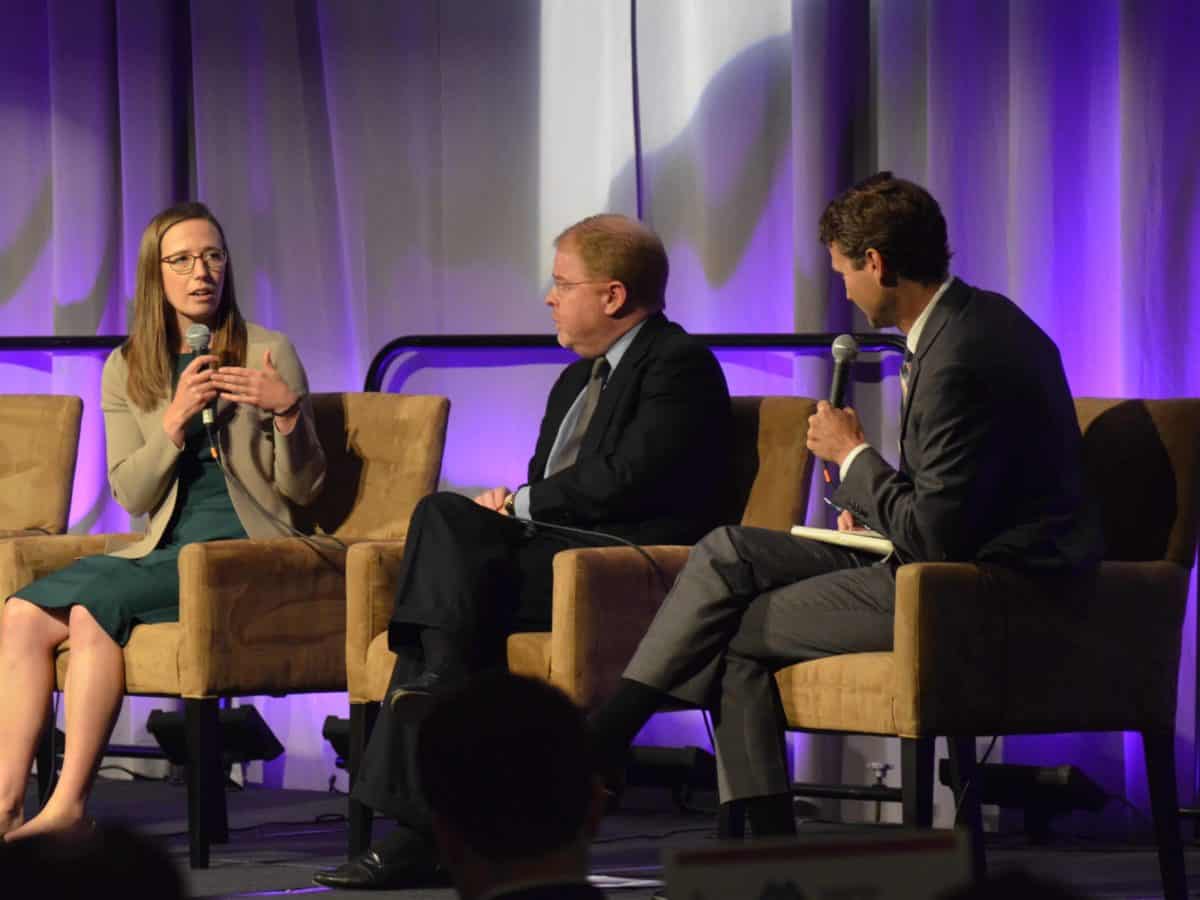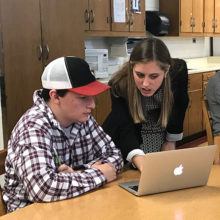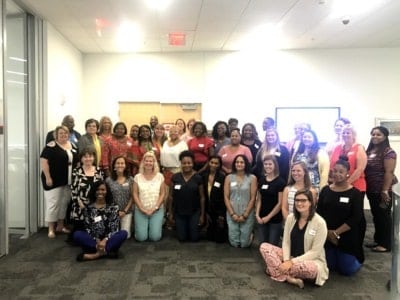

Last week, the NC Chamber conference on education brought together business and nonprofit leaders, philanthropists, elected officials, community college leaders, and educators to discuss how each of these stakeholders can work together to increase educational attainment for all North Carolinians and meet the state’s workforce needs in the future. With presentations on the state’s talent pipeline, increasing third-grade reading proficiency, and bringing career relevance into the classroom, to name a few, the conference highlighted opportunities and challenges of meeting North Carolina’s workforce needs.
One theme that emerged from the conference was the idea that while each set of stakeholders can make an impact on educational attainment separately, truly increasing educational attainment for all North Carolinian’s will take the collaboration of all groups, from business to philanthropy to educators to elected officials. David Fountain, North Carolina President of Duke Energy, said it best in his opening speech:
“The thing that I hope emerges from this discussion today is the fact that we can’t do this alone…The journey from pre-K to career can take up to two decades…Success over that length of time really depends on collaboration and efforts between parents, educators, employers, elected officials, and community leaders.”
The challenge
Rebecca Tippett, founding director of Carolina Demography, offered a sobering presentation on the talent pipeline in North Carolina today. Tippett pointed out that much of the increase in North Carolina’s education attainment over the past few decades has come from importing talent rather than growing our own talent. While North Carolina has made strides increasing the on-time high school graduation rate, there is much work to be done getting students from high school graduation to holding an associate’s degree, bachelor’s degree, or high-quality certificate. For every 100 ninth-graders in North Carolina currently, only 30 will have a postsecondary degree 10 years later, and 23 will have some college but no degree.
From an initial group of 100 9th graders in NC, 10 years later only 30 will have a bachelor’s or associate’s degree and 23 will have some college but no degree #WorkReadyNC @EducationNC @ncdemography pic.twitter.com/bJat1RHwkp
— Molly Osborne (@mosborne917) August 15, 2018
In addition, there are large attainment gaps, both by race and ethnicity and between rural versus urban in North Carolina. Tippett stressed the need to look beneath the top-line attainment numbers and break it down by demographics. For example, while the Triangle region has the highest degree attainment rates in the state, it also has some of the largest gaps in attainment between whites and blacks and whites and Hispanics.
NC has large attainment gaps when broken down by race and ethnicity. Tippett says many of our communities that are doing best in terms of overall attainment have the worst gaps when we look at breakdown by race/ethnicity #WorkReadyNC @EducationNC pic.twitter.com/vGcSbKtia0
— Molly Osborne (@mosborne917) August 15, 2018
These attainment gaps have implications for the future of North Carolina’s home-grown workforce. Tippett shared that 44 percent of North Carolina K-12 public school enrollments are black, Hispanic, or American Indian — so North Carolina must address attainment gaps in order to meet future workforce needs.
“This is the challenge, this is the call to action.” Tippett points out that in order to meet attainment goals, NC must bring up attainment levels of black, Hispanic, and American Indian students – many of whom would be first generation college students #WorkReadyNC @EducationNC pic.twitter.com/IdgPykQob3
— Molly Osborne (@mosborne917) August 15, 2018
For the remaining sessions, business leaders, philanthropists, and education leaders shared how they are collaborating to tackle these challenges. A good example of this collaboration is the work businesses, researchers, government agencies, elected officials, and educators are doing to expand access to NC pre-K.
Increasing access to NC pre-K
For the past two years, the state legislature has increased funding for NC pre-K, yet there is more work to be done. Jim Hansen, Regional President-Eastern North Carolina at PNC Bank, presented on the business case for expanding access to NC pre-K. Hansen and a group of North Carolina CEO’s have set a goal of 75 percent of eligible children in North Carolina enrolled in NC pre-K.
Citing research from Duke University on North Carolina’s pre-K program, Hansen said students who are enrolled in NC pre-K have higher test scores in math and reading, are less likely to be placed in special education, and are less likely to be held back in third, fourth, and fifth grades. These positive outcomes generate net savings of $46 million within four years of initial investment, Hansen stated.
Reaching the 75 percent goal is not as simple as it sounds, however. “It’s a harder lift than any of us in the business community who got engaged with this anticipated,” Hansen stated.
To better understand how to reach that goal, PNC partnered with SAS and NIEER (National Institute of Early Education Research) to do a deep dive on NC pre-K enrollment data. Hansen shared some of their preliminary findings at the conference, highlighting two barriers to expanding access to NC pre-K: using pre-K wait lists to determine demand for pre-K and a lack of funding in many counties to expand pre-K despite increased state funding.
The number of children on NC pre-K wait lists has been used as a measure of demand for pre-K in state legislation, Hansen stated, but there are many problems with using wait list numbers to measure demand or need for NC pre-K. First, there is no consistency in keeping wait lists: “Counties aren’t required to keep [wait lists],” Hansen stated, “and when they do keep them, there’s nothing telling them how to keep them. So there’s no consistency in using wait lists as a data point in how we look at NC pre-K.”
There are also many reasons why families may choose not to enroll their child in NC pre-K, and thus, those children are not reflected in wait list numbers. Hansen gave several examples: “We all know families may not seek to enroll if they don’t know about the program, understand the benefits, don’t bother to enroll, can’t prove eligibility, struggle with transportation, getting a child to school, work schedules — I can come up with many reasons we all understand why a child’s family may never show up on our radar screen as a wait list data point.”
Hansen then shared data from pre-K enrollment in 2017, when the state provided funding for an additional 1,750 pre-K seats. According to Hansen, only 56 of North Carolina’s 100 counties requested additional pre-K slots. Those counties had capacity for 4,800 seats, which became the wait list number, but they actually requested 6,000 seats.
Hansen explained, “The problem is that at a county level, current capacity for the ability to enroll a child at any point in time is not a measure of demand, it is not a measure of need…and it is not reaching the families it is designed to serve, so we have to move beyond the label of wait list as a measure of demand, especially when we know there are 30,000 unserved children across our state.”
The second barrier to expanding access to NC pre-K is that many counties do not have the funding required to expand pre-K seats. Hansen shared that in 2017, 44 counties declined the new state funding to add seats, even though they had 9,000 eligible children. To increase pre-K seats, state legislation mandates that counties provide 40 percent of the funding for each new seat and the state will provide 60 percent.
.@JimHansenPNC talks about the barriers to expanding NC pre-k, including the cost. He says many counties turned down state funding to expand pre-k because they could not provide the matching funding required #WorkReadyNC @EducationNC pic.twitter.com/F15M8W0drA
— Molly Osborne (@mosborne917) August 15, 2018
PNC, SAS, and NIEER are working with the Department of Health and Human Services to better understand why these counties declined funding, but Hansen noted that these counties face many barriers to increasing pre-K seats, including recruiting teachers, facility costs, and transportation costs. Ultimately, Hansen said, “It goes back to many of these counties don’t have the revenue streams.”
Moving forward, Hansen stated, they will continue working with the NC Chamber, the General Assembly, and the Governor to examine these barriers and expand access to NC pre-K for all eligible four-year-olds.
Hansen ended saying, “As business leaders, we have a very long outlook on this. I always equate to — I give you a 30-year mortgage because I believe you are going to pay it back and I want you in your home today. I have the very same thought with a four-year-old. I want to see their future with a job 30 years or 20 years from now. We have to have that outlook if we’re going to be successful in North Carolina.”


